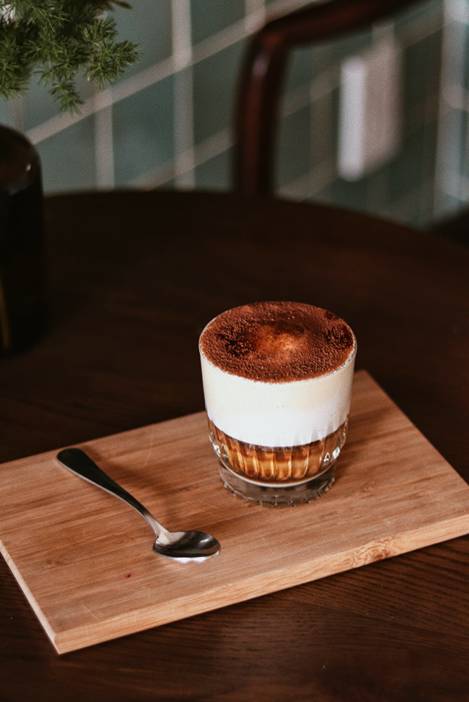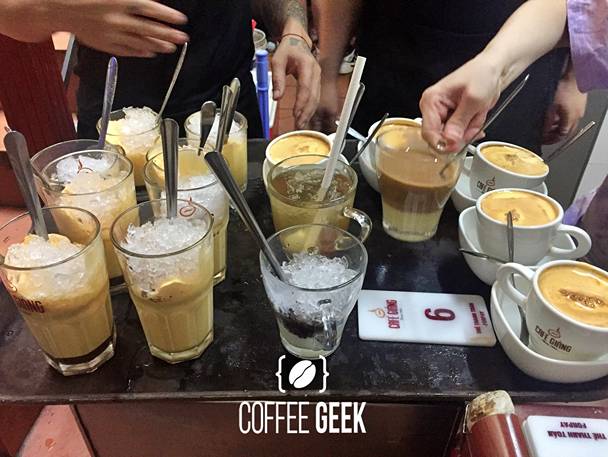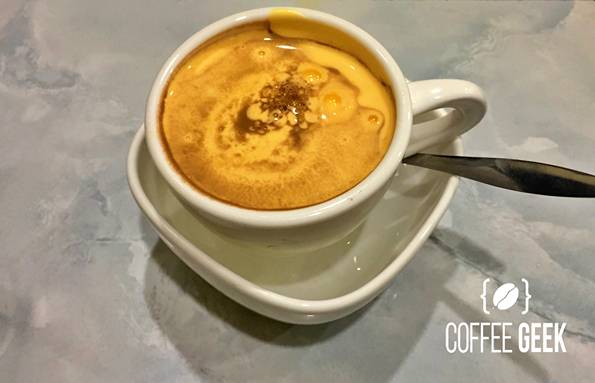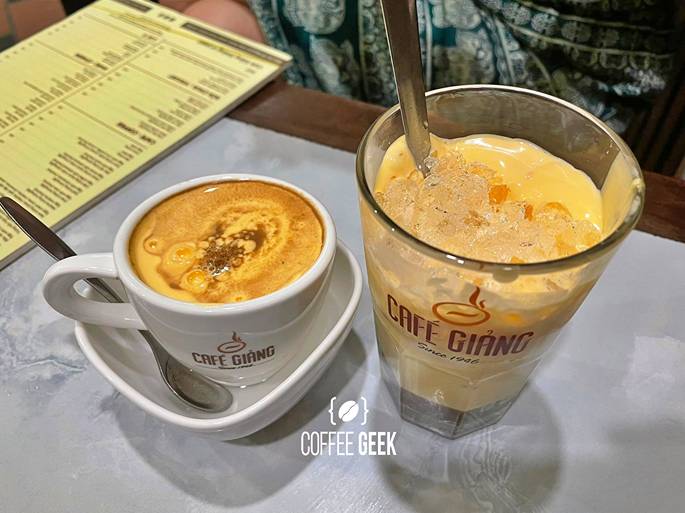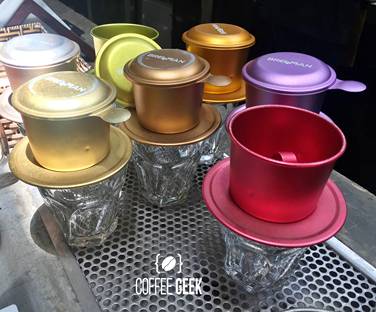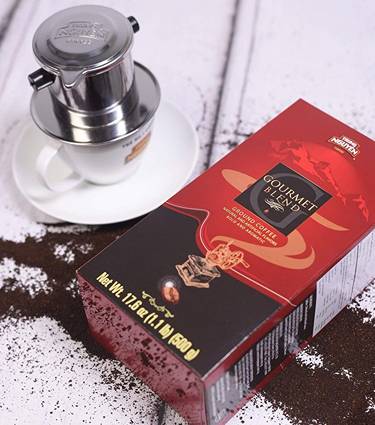Vietnamese people love a good cup of coffee. And they’re globally renowned for making some truly delectable coffee creations.
The history of coffee in Vietnam goes back as far as coffee itself, but innovative coffee-based beverages started cropping up in this country decades before they became trendy in the west.
Lots of travelers and ex-pats with an appreciation for top-notch coffee find themselves totally hooked on Vietnamese iced coffee in its unique and delicious forms.
Some of those coffee lovers end up with a tall glass of Vietnamese coffee in one hand, their AeroPress coffee maker in the other, and a head full of wildly firing neurons as their delightfully caffeinated brains try to mash the two concepts together to make AeroPress Vietnamese Coffee.
Or maybe that was just us.
Regardless, after a few hours of mildly challenging calculus and cooling down with some more iced coffee, we’d figured it out.
From that point forward, we held the power to create incredible Viet coffee in our AeroPress—whenever we’re able to get our hands on some sweetened condensed milk or an egg, anyway.
Types of Vietnamese Coffee
Before you start dumping condensed milk on top of your ground coffee in your brew chamber, understand that there are two distinctive forms of famously amazing Vietnamese coffee.
Hot Coffee with Sweetened Condensed Milk (cà phê sữa nóng)
Most commonly in Vietnam, you’ll be having cà phê sữa nóng, which is dark roast coffee brewed in a single serving using Vietnam’s special Phin filter.
It’s brewed using nearly espresso roast coffee—most famously Trung Nguyen coffee—directly into your coffee cup.
Like in many Southeast Asian cultures, milk features prominently in Vietnam’s take on dark roast coffee.
In this case, it’s sweetened condensed milk in particular that makes the beverage what it is.
Vietnamese Iced Coffee (cà phê sữa đá)
While cà phê sữa đá (iced coffee) is distinct from cà phê sữa nóng (Vietnamese hot coffee), it’s the former that tends to be the default in the country.
With tropical weather and often sweltering heat, most people like their coffee to cool them down in the form of a refreshing pick-me-up.
If you order a coffee, the assumption will likely be that you’d like it iced. Having said that, aside from the ice, the recipes for the condensed milk brew are identical.
Vietnamese Egg Coffee (cà phê trứng)
What’s definitely very much not identical, is cà phê trung, or Vietnamese egg coffee.
This recipe is very special, super interesting in its origins, and most importantly, absolutely incredible.
We’ll explain the details in depth, but it basically involves mixing a couple of egg yolks and sugar into your coffee.
Nowadays condensed milk is also a staple in this version of Vietnamese iced coffee, but when the drink got its start, it was actually meant to be an alternative.
But Why Egg Coffee?
Egg coffee was invented in 1946 by a Vietnamese bartender, Giang, during a time when milk was scarce in the country.
He used egg yolks and sugar instead of condensed milk to create the distinctive, thick foam that Vietnamese people were fond of in their coffee.
The yolks were whisked along with the sugar to create a thick, creamy texture that acts as a great alternative to condensed milk.
Is It Good?
Well, that depends. Do you like things that are delicious?
Think of a tiramisu or a crème brûlée, then imagine they were always meant to be enjoyed as a beverage—and you didn’t have to wait for dessert at a fancy restaurant to get the best of them.
Also, it’s coffee.
That’s basically what Vietnamese egg coffee tastes like.
Nowadays, since sweetened condensed milk is thankfully no longer difficult to come by, that’s been added back into the mix in most recipes, along with a bit of vanilla extract and sometimes a dash of cinnamon on top.
Global Aspirations
While egg coffee isn’t as common in the United States, it’s thoroughly enjoyed throughout Vietnam by locals and foreigners alike.
After a trip to the country, Sara Leveen and Ben Lowell visited the famous Cafe Giang and fell in love with the local cuisine.
The couple later opened Hanoi House in New York City, and their version of the egg coffee recipe has since become a staple in their restaurant.
The Phin Filter — The Vietnamese Coffee Maker
When placed on top of a glass or coffee cup for brewing, it actually looks a bit reminiscent of a tiny AeroPress if it were made of metal.
The Phin filter is a marvelously simple and elegant little coffee maker that brews Vietnamese coffee in a single serving, often on top of a clear glass.
Essentially, it’s a drip coffee maker of the simplest nature—the anti-espresso maker, if you will.
But the famously strong coffee it’s normally used to brew is comparable to espresso in strength and flavor. Hence the sweetened condensed milk.
Notably, the brewer is meant to be used absent of a paper filter, which means a bit of ground coffee is likely to make its way into your cup, similarly to how a French press can allow for the same.
Using one is extremely simple. You grind your coffee beans to a semi-course grind size, add your coffee into the brew chamber, and then pour boiling water over the coffee.
Allow the coffee to bloom for 30 seconds to a minute afterwards, and then add additional hot water as needed or to taste.
How to Make AeroPress Coffee Vietnamese Style
It’s relatively straightforward to make your favorite style of Vietnamese iced coffee (or even hot versions) with an AeroPress.
Since both condensed milk and egg variations of Vietnamese coffee are essentially made by adding either coffee to a glass of milk or an egg mixture to a cup of pre-brewed coffee, you can easily replace a Phin filter with your trusty AeroPress.
The biggest challenge you’ll likely have in your pursuit of Viet coffee goodness is obtaining the ingredients.
If you’re happy with any brand of condensed milk and willing to experiment with different ratios of brown or white sugar based on what’s available to you, you’ll be just fine.
Cà Phê Sữa Nóng — Hot Coffee with Sweetened Condensed Milk
To make the simplest kind of Vietnamese coffee with your AeroPress, you’ll start simply by adding between 1-3 tablespoons of sweetened condensed milk to a mug or tall glass.
Longevity Brand is a popular favorite, but you can hack up some of the key ingredients yourself if you can’t get your hands on any in-store.
While any kind of coffee will do in a pinch, to get the most authentic taste, you’ll want to use some Vietnamese coffee (like Trung Nguyên coffee).
Short of that, you can use some ground robusta beans to achieve a base coffee taste that’s not far off.
Brew the coffee with your AeroPress straight into the glass containing the condensed milk, and then stir the mixture to help it saturate and froth up into a delightful beverage.
Cà Phê Trứng — Vietnamese Egg Coffee
This recipe takes just a bit more prep work, but it’s totally worth it.
Important Note
You’ll be using and consuming raw eggs in this kind of coffee, so it’s important to either buy pasteurized eggs or to pasteurize them yourself by cooking them over low heat before you drink them.
Instructions
Step 1: Brew your coffee. Just like with the cà phê sữa nóng recipe, true Vietnamese coffee or strong espresso roast coffee is highly recommended.
Step 2: Whisk your egg yolk mixture, containing 2 egg yolks (large is best), around a teaspoon of sugar, and just 1/8th teaspoon of vanilla extract.
You’ll want it to get nice and frothy, so we recommend using an electric mixer if one’s available.
Pour or scrape your egg mixture over your freshly brewed coffee.
The result should be a yellow-brown-colored beverage with a light, bouncy foam on top.
From here, you can add a dash of cinnamon on top, which makes for a yummy addition and gives the coffee a cafe-brewed look, if your aim is to impress.
What About Vietnamese Iced Coffee?
Either of these two recipes can be made in iced form simply by pouring the mix over a glass full of ice, or by adding ice afterwards. It’s as simple as that!
If you’d prefer to avoid having ice melt into your coffee, you can always pre-make some coffee ice cubes or have some AeroPress cold brew ready to go in advance.
Wrap-Up: Making AeroPress Vietnamese Coffee
If you’ve ever had some Vietnamese coffee, you’re likely very interested in being able to recreate the delicious treat on your own, especially if it’s not readily available at any of your local cafes.
Fortunately, both Vietnamese iced coffee made with condensed milk or frothy egg yolks (or both) are relatively simple recipes that can be easily recreated using your AeroPress.
Since Vietnamese coffee is always essentially 2 key parts, you can brew your coffee separately using your AeroPress or any other coffee maker, before mixing it with sweetened condensed milk or your egg yolk and sugar mixture.
If you can’t get your hands on any authentic Vietnamese coffee to use in your home recipe, just bear in mind that coffee in Vietnam tends to be quite strong, so substitute for robusta beans or espresso grounds in a pinch.
Happy brewing!
Want something a little more filling? See our Aeropress bulletproof recipe here.


